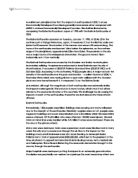What caused the Soufrire Hills Volcano to erupt?
What caused the Soufrière Hills Volcano to erupt? The Caribbean island of Montserrat is situated on a destructive plate boundary. A plate boundary occurs when two of the plates that make up the surface of the earth meet. Underneath Montserrat the Atlantic plate is slowly being forced under the Caribbean plate. This happens because the oceanic plate is denser than continental plate. Convection currents pull the dense Atlantic plate into the mantle where intense heat and friction cause the rock to melt. This molten rock is lighter than the surrounding rock, forcing it to rise through cracks in the in the rock towards the earth's surface. Molten rock or magma gathers under the volcano until the pressure is so great that it is forced up through a vent towards the surface of the earth. The Soufrière Hills Volcano produces a thick sticky lava called andesite. The lava is so thick that it builds up at the top of the volcano in a dome until it becomes too heavy and the dome collapses. When the dome collapses hot rocks, gases and ash are released from the volcano causing the following hazards. Pyroclastic flows are extremely fast-moving flows of lava, hot rocks and gas that flow down the side of the volcano. Pyroclastic Surges are fast-moving clouds of hot ash that travel with the pyroclastic flow. Tiny pieces of volcanic ash are blasted into the air forming a plume of ash. As it
Why do similar kinds of hazards have different impacts in different places?
Why do similar kinds of hazards have different impacts in different places? Similar kinds of hazards can cause a different scale of impact in different places due to many factors, the main influence being the countries economy. A hazard is an unexpected event or process which affects people, causing loss of life or injury, economic damage, disruption to people's lives or environmental degradation. A natural hazard could become a disaster when is has serious effects such as a large loss of life or property. The disaster risk has many factors which could increase or decrease the risk. This can be shown in an equation; Disaster Risk = Hazard X Vulnerability Capacity Hazard relates to the frequency of the hazard or the scale of the hazard, for example the magnitude of an earthquake, or the height of a wave. Vulnerability is the conditions determined by physical, social, economic and environmental factors which increase the susceptibility of a community to the impact of hazards. Capacity is the combination of strengths and resources available that reduce risk. Hurricane Katrina, 2005, New Orleans. Hazard: Hurricane Katrina passed east of New Orleans and winds downtown were in the Category 4 range with a minimum central pressure of 902 millibars and frequent intense gusts and tidal surge. 80 percent of New Orleans was flooded, with some parts under 15 feet of water.
Marine Pollution
Marine Pollution I am writing to convince the UK Government that it is time to take action to protect the seas around us. The harm being done to our oceans is damaging in many ways - not least because with increasing speed, we are severely depleting the world's stock of fish. For four centuries the seas have been considered on inexhaustible resource from which people could take as much as they wanted. Now we have to face up to the fact that our oceans are not limitless - more and more people competing for less and less fish are which is making the existing crisis worse. Many marine ecosystems are at the point of collapse and will be destroyed unless we act quickly to protect them from the most serious threats. Pollution from ships Ships can pollute waterways and oceans in many ways. Oil spills can have devastating effects. While being toxic to marine life, polycyclic aromatic hydrocarbons (PAHs), the components in crude oil, are very difficult to clean up, and last for years in the sediment and marine environment. Discharge of cargo residues from bulk carriers can pollute ports, waterways and oceans. In many instances vessels intentionally discharge illegal wastes despite foreign and domestic regulation prohibiting such actions. Ships create noise pollution that disturbs natural wildlife, and water from ballast tanks can spread harmful algae and other invasive














